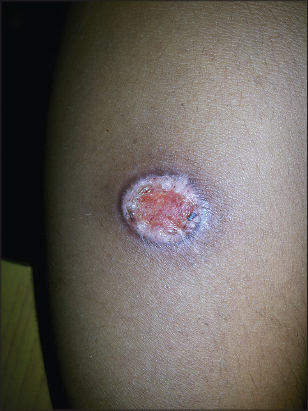|
Get Citation
|
|
|
Desai CA. Granulomatous reaction following mantoux test: A rare complication. Our Dermatol Online. 2017;8(4):507-508 |
|
|
Download citation file:
|
Granulomatous reaction following mantoux test: A rare complication
Chirag Ashwin Desai
Department of Dermatology, Kasturmahal Polyclinic, Sion (east), Mumbai, India
Corresponding author: Dr. Chirag Ashwin Desai, E-mail: 83.chirag@gmail.com
Submission: 22.11.2016; Acceptance: 20.02.2017
DOI: 10.7241/ourd.20174.147
Sir,
Tuberculosis (TB) is one of the major public health problems in our country. More so with growing resistance of mycobacterium tuberculosis to various drugs, treatment of this disease is becoming more complex. Various factors like high cost, limited resources and poor performance of diagnostic tests make diagnosis of this disease more difficult. Tuberculin skin testing (TST) is one of the diagnostic modalities to detect TB in an individual.
A 13-year-old boy came with the chief complaint of a recently developed asymptomatic lesion on left forearm which was gradually increasing in size. On inquiry the patient had a chronic cough for which he had visited a physician 15 days back. He has advised a battery of investigations including hemogram, chest x-ray, Mantoux test and sputum for acid fast bacilli. One week following the Mantoux test, the patient reported an increase in redness and hardness at the site of test which progressed to a current state of his lesion. On examination, there was a 5 cm x 7 cm ulcerated area with rolled up edges and surrounding induration. No pain or tenderness was associated with this lesion. A biopsy was done to determine the nature of this lesion as it did not appear to be usual ulceration that occurs with severe Mantoux positivity (Fig. 1).
Biopsy from the edge of the lesion revealed a hyperplasia of epidermis with well formed tuberculoid granulomas in the dermis comprising of epithelioid cells, lymphocytes and Langhans giant cells with some caseous necrosis in the centre of the granuloma (Figs. 2 and 3). A final diagnosis of tuberculoid granulomatous reaction following Mantoux test was kept. The patient did follow up once after the biopsy for the report following that he was lost to follow-up.
TST was originally developed by Robert Koch in 1890; however, the intradermal mode of administration was described by Charles Mantoux in 1912 [1,2]. There are various factors both in the host and in the test that lowers the sensitivity and specificity of this test, consequently, the test may be positive in an un-infected child and negative in a patient with full blown TB [1].
The tuberculin that is used presently for the test is called purified protein derivative (PPD), derived from cultures of mycobacterium tuberculosis. A standard dose of five tuberculin units (0.1 ml) is injected intradermally on left forearm of the patient and the reaction is read after 48 to 72 hours. Features of reaction include erythema and induration at the injection site. The amount of induration is measured transversely to the long axis of the forearm and is recorded in millimeters [1].
This is a form of delayed-type hypersensitivity reaction. Occasionally there may be vesiculation and necrosis at the site. Adverse effects associated with this test include allergic reactions in form of excessive redness and swelling of the arm, urticaria at the site, vesiculation and ulceration at the site, foreign body reaction to the injected material. Regional lymphangitis and adenitis have also been reported. Lesser known adverse effects include anaphylactic reaction and granulomatous reaction at the injected site [2].
This case shows a granulomatous reaction at the site of injection which is an entity with fewer reports in the literature.
REFERENCES
1. Nayak S, Achariya B. Mantoux test and its interpretation. Indian Dermatol Online J. 2012;3:2–6.
2. Praveen R, Bahuguna A, Dhadwal BS. Tuberculin skin testing: Spectrum of adverse reactions. Indian J Public Health [serial online]. 2015;59:213-6.
Notes
Source of Support: Nil
Conflict of Interest: None declared.



Comments are closed.